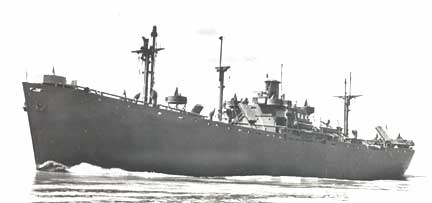LITTLE-OTTO
OTTO MARSHALL LITTLE JR.

S1

ONE OF THE MOST REMARKABLE SURFACE BATTLES OF WWII
The SS STEPHEN HOPKINS, a 7181-ton U.S. Merchant Marine Liberty ship, was launched in May 1942 at the Kaiser shipyards in Richmond, California. Her namesake was Stephen Hopkins, a signer of the Declaration of Independence. Her maiden voyage took her from San Francisco to Bora Bora, New Zealand, Australia, South Africa and then into the Atlantic Ocean bound for British Guiana, where on the morning of September 27, 1942, she met her fate off Surinam. While proceeding through haze she spotted two ships coming out of the fog not far away. The ships were the German surface raider STIER and its supply ship TANNENFELS. The STIER was a former merchant ship disguised as a neutral-flag cargo ship but her profile had been changed with the addition of fake masts and stacks, and she now carried six 5.9-inch guns hidden behind false deck panels. A scant three minutes after the two ships were sighted and they neared to about 1,000-yards, shots suddenly pierced the STEPHEN HOPKINS superstructure. General alarm was sounded and as Navy Armed Guard gunners and mariners assigned as loaders raced to their guns they saw a ship off the starboard bow about their same size firing at them. Thus began one of the most remarkable surface battles of World War II. Explosions rocked the ship and machine gun fire was raking the decks. One of the first shells killed two mariners as they stepped on deck. The order was given to steer STEPHEN HOPKINS so the stern with its single 4-inch gun would point at the enemy and at the same time present the smallest target. Although severely wounded by shrapnel, the commander of the Armed Guard expertly directed the 4-inch gun at the waterline of the German raider, getting a shot off about every 45-seconds. They made every shot count as they hit the STIER’s rudder and then damaged its forward guns.
The STEPHEN HOPKINS also took damaging shots as one pierced the hull hitting directly into the engine room. Those above heard an explosion, then the roar of steam as the black gang died at their posts as the ship went almost dead in the water. The STIER continued putting shell after shell into the upper works of the STEPHEN HOPKINS. A large caliber shell hit near the 4-inch stern gun killing all the men nearby. A Merchant Marine cadet saw the 4-inch gun was deserted, so although untrained, he manned the gun alone and fired all five shells left in the ready box, scoring hits with all five. Very shortly thereafter the cadet was killed by a shell which exploded nearby. The firefight lasted about half an hour and a total of 35 shells hit STIER, leaving her in shambles as was the STEPHEN HOPKINS. Both ships were on fire and sinking. After an hour or so she sank as did the STIER after her captain ordered his crew to abandon ship and set detonating charges to scuttle the ship. Upon returning to Nazi territory the captain reported he fought a “heavily armed cruiser.”
Crewmen of the STEPHEN HOPKINS gathered on one lifeboat and searched for their shipmates but were successful in gathering from the foggy ocean only 19 survivors from the 60 men who had been aboard. With little food and water the survivors miraculously sailed 2,200-miles in a 31-day journey to Brazil. Fifteen men survived. When news of the battle was released the STEPHEN HOPKINS was hailed as a “Hero Ship” and the ship and its crew was awarded the U.S. Maritime Commission’s Gallant Ship Unit Citation. During World War II it was the only U.S. merchant ship to sink a German surface warship.
Otto Marshall Little Jr, Seaman First Class, was a member of the Navy Armed Guard. Unfortunately he was one of the men lost in the sinking of the STEPHEN HOPKINS and was probably killed while manning his battle station. Little information has been recorded concerning him other than that his hometown was Coalgood, Kentucky.
Submitted by CDR Roy A. Mosteller, USNR (Ret)

